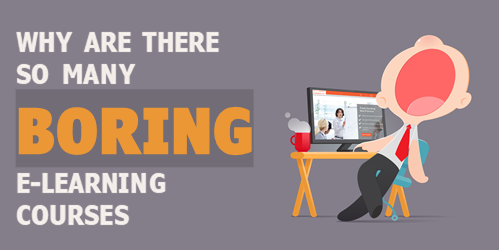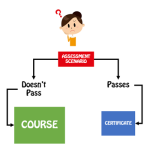Amen! Preach!
Why There Are So Many Bad E-Learning Courses
April 20th, 2021
Like many organizations, we have to take compliance training. And when I heard we had a 3-hour harassment course coming, my first emotional response wasn’t positive. Why do I shudder thinking of taking a 3-hour e-learning course?
We all know why.
I hear all the time that e-learning courses are boring. This isn’t 1995. What’s going on?
We have conferences that teach us how to build better courses. We have an industry full of experts whose whole existence revolves around pointing out boring e-learning and selling their services to de-borify.
I write this blog hoping to combat boring e-learning. We discuss this often in the community and present weekly challenges to instigate thinking about interactive content in different ways. And yet, a lot of e-learning is still boring. Why?
Here are a few observations based on my experience.
Boring E-learning Has Always Existed
Working for a software vendor, I hear all that time that we make boring e-learning possible. The argument is that we’ve equipped too many ignorant people to create “courses.” Apparently, only highly trained instructional designers can build good e-learning. Hog wash! This opinion is both elitist and wrong.
I’ve been in this industry long before the rapid authoring tools were around. E-learning was just as boring then as now. The only difference was that it cost more to make it so there were fewer boring e-learning courses. But trust me, the e-learning courses back then were a lot worse than the ones we have now. And they weren’t created by ignorant people; they were created by instructional designers.
The tools don’t create boring courses, but I will admit that they do make it easier to create a lot of them. But the problem isn’t the authoring tools.
Organizations Get What They Pay For
I’ve been part of hundreds of workshops and talk to people in organization both big and small. And most have a few things in common. The organization buys the software and that’s about it. The developers don’t tend to get much more and must cobble together all sorts of things to build their courses.
But there’s a lot that goes into building great courses.
For many organizations, there’s minimal commitment to ongoing training so that the developers can get more out of the software investment or learn to build better learning experiences. There’s not a lot of commitment to designers who can help craft the right UX designs or graphic designers who can build compelling visuals that support the communication of the content. There’s no multimedia support or access to programmers. Many times, the course developers aren’t even connected to the ones who manage the learning management systems.
Good e-learning requires more than good e-learning software. It requires a commitment to an effective e-learning strategy that helps craft the best learning experiences. I see that many organizations stop at the good software part and let things go from there. And the result is understaffed e-learning developers who operate at the insane speed of business, cranking out content like crazy with little additional support.
That’s a recipe for boring e-learning.
Too Much Focus on Content
When it comes to teaching, we’re very content-centric. Need to know how to change a tire? Go to YouTube. Not sure how to handle this process? Read this PDF. If there’s a need, the gut reaction is to throw more content at it.
Content is fine and obviously part of the learning process. But content isn’t THE learning process. Yet most of the e-learning I see is a lot of content. And it’s often stuff already available in some digital format and then repurposed to look like a course. Add a ten-question quiz and call it good.
Content should be tethered to two things:
- meaningful, relevant context
- performance-based activity
Courses are boring because the content is completely meaningless to the person taking the course (which is the case for a lot of compliance training). Or it’s not framed in a relevant context that helps them understand the content in their real lives.
And then, the course stops at just sharing content with a quiz. There are no supporting activities to practice using it. There’s no opportunity to make real-world decisions and get feedback.
You want your e-learning courses to not be boring? Make an investment in a team that can build good courses, give them the right resources, and focus on learner-centric activities rather than content dumping.
That’s a step in the right direction.
Events
- Everyday. Check out the weekly training webinars to learn more about Rise, Storyline, and instructional design.
Free E-Learning Resources
 |
 |
 |
|
Want to learn more? Check out these articles and free resources in the community. |
Here’s a great job board for e-learning, instructional design, and training jobs |
Participate in the weekly e-learning challenges to sharpen your skills |
 |
 |
 |
|
Get your free PowerPoint templates and free graphics & stock images. |
Lots of cool e-learning examples to check out and find inspiration. |
Getting Started? This e-learning 101 series and the free e-books will help. |
10 responses to “Why There Are So Many Bad E-Learning Courses”
The reason a lot of compliance training courses are boring is because of the requirements regulators impose for course approved. Another factor is the lack of “good” internet in all areas, particularly rural areas, leaving text-and-graphics as the most reliable mainstay to reach the masses. I’ll just add that being capable of more doesn’t always mean that it’s the best choice for every situation.
Tom’s dropping the “hog wash” – love it! As always, a great article that hits the main pain points for those of us who fight to build interesting, engaging, relevant content for learners. Thank you for summarizing the issue so well. #Preach
100% agree! One of the big issues we face, especially in our subject area (EMS continuing education), is the focus on seat-times rather than outcomes and/or competencies.
Currently, it’s hard for a designer to quantify “seat times” without gobs of content to increase the tangibility of the seat time. We can easily argue x number of words = average reading time of 1hr. It’s even easier when the content is narrated and “locked down” forcing the learner to mindlessly sit while the content plays through for them at a pre-defined speed. It becomes harder to quantify time on task when the task is an interactive learning object where the time on task varies from learner to learner, which, rather ironically, is much the same as achieving competencies. One day, in the not so distant future, we will focus less on seat times and more on the true purpose of education, outcomes and competencies.
I produce e-learning courses for various big companies, but it’s everywhere the same: Low budget, little time, strict requirements (I don’t know who made them, but they were certainly no e-learning experts), and an AWFUL lot of content. Often my attempts to involve more interactions are considered as “unnecessary” and I have to remove them. I really start hating my job.
Because I love your postings, this isn’t meant to be too critical about the BORING E-Learning item per se but…
Managements are always thinking about the ‘bottom line’ – what is costing them money and how they can earn more. Because of this, those who promote ‘cutbacks’ etc. always get the manager’s ear.
Employees need to counteract these job snipers by finding ways/techniques to regularly remind their employers about the significance of the work they do for the organisation. When you are at the coal-face of a company’s operation your value is regularly noticed and you don’t need to ‘maintain’ your position. Most employees are not central to operations and need to be aware of this fact. Someone somewhere is deciding your future.
Because ‘snipers’ rarely know as much about the job you do – as YOU do – it pays to have – and implement – killer responses to the slightest hint of a threat.
In my opinion, these responses work best when delivered directly INTO the management ear. Submissions should focus on what YOU do rather than on fleshing out, and giving substance to, the attackers point of view – except where you deliver your killer response.
I’ve seen counter-arguments that presented the attackers’ point of view much better than the attacker themselves.
The piece below, while intending to be supportive of the work of technical writers, does as much, if not more, to kick its own butt than it does to support it.
Many people would not have had an opinion about e-learning courses prior to this – but they will now!
And all because an eye-catching graphic where the word BORING got the greatest emphasis followed by ‘the argument’.
The first and most immediate effect is one of telling potential readers that THIS IS ABOUT A BORING SUBJECT.
The second most immediate effect is telling potential readers that E-LEARNING IS THAT BORING SUBJECT.
What a perfect opening line for a Management letter about planned redundancies.
Dear fellow employee,
Let’s face it – E-Learning is BORING!
Hey, Thanks a lot for sharing this information. I will share this with my sister.
I appreciate your honesty about E-Learning courses. I could not agree more that nobody is excited to take a 3-hour E-Learning course that is not relevant to them. Every time I see an E-Learning course relating to global in my LMS at work, I just roll my eyes. How am I going to find the time to complete my activities for the day and then squeeze this course that doesn’t relate to my daily responsibilities?
Currently I am in a master’s program for Instructional Design, while working as a Lead Qualified Trainer. Due to the pandemic, I am responsible for converting Instructor-Led Trainings into Web-Based Trainings. My biggest challenges are time and the material. The material is not very exciting to begin with so the content tends to be boring and management is pressuring me to get all my projects out as fast as possible. Time is money as they say.
Your blog has opened my eyes to start adding activities within the course to connect the content more easily. This can help with retaining the information and then apply it to their work tasks.
After completing E-Learning courses, there has not been an opportunity to provide direct feedback to the author of the course. Moving forward I plan on adding a button at the end of the courses that links to my email address. This will give the learners a chance to provide me with feedback. Hopefully it’s constructive feedback, fingers crossed!









0
comments